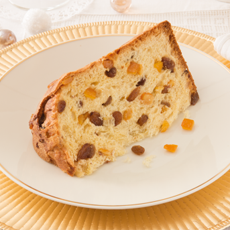RECIPE: Nutella French Toast
|
|
Panettone (pah-neh-TOE-nay) began in medieval Italy as a Christmas bread; but today, the fluffy yellow yeast bread variously filled with raisins, other dried fruit and orange peel, is available year-round. There’s also a version with chocolate bits—an ingredient not available until the latter half of the 19th century. Bauli, whose panettone is imported into the U.S., creates year-round recipes Raspberry Jam & Hazelnut Spread Stuffed Panettone French Toast. We have more panettone recipes, too: Panettone Bread Puddin, Panettone Classic French Toast and a Panettone Nutella Sandwich. > The history of panettone is below. > The history of French toast. > The different types of bread. > The different types of cake. Think of this as the most indulgent peanut butter and jelly sandwich you’ve ever had—except that it’s a chocolate hazelnut spread instead of peanut spread. You can make it for breakfast, but also eat it for dessert. Ingredients For 2 French Toast Sandwiches For The Whipped Cream 1. WHIP the cream and vanilla with a hand mixer until soft peaks form. Add powdered sugar and mix until incorporated. 2. WHISK together the milk, eggs, cinnamon, and vanilla. Melt butter in a pan over medium heat. Soak Panettone slices in the mixture for 30 seconds on each side. Place bread into the pan and cook until the bottom is golden and crisp. Turn, and repeat with the other side. Repeat with all of the bread, keeping it warm in a 200° oven. 3. SPREAD 2 tablespoons of hazelnut spread and 2 tablespoons of jam on two of the bread slices. Top with remaining slices and a dollop of fresh whipped cream. Serve warm. |
|
|
ABOUT PANETTONE Panettone is a medieval Italian Christmas yeast bread, filled with candied fruits and raisins. The Milanese specialty is tall, dome-shaped, and airy, in contrast to the other famous Christmas bread, panforte, which is is short and dense (although there is a less common, flat version of panettone). Panettone means “large loaf” in Italian. While the origins of a sweet leavened bread date back to Roman times, and a tall, leavened fruitcake can be seen in a 16th-century painting by Pieter Brueghel the Elder, the first known mention of panettone with Christmas is found in the 18th-century writings of Pietro Verri, who refers to it as “pane di tono.” The dough is cured for several days (like sourdough), giving the cake its distinctive fluffiness. Raisins, candied orange peel, citron, and lemon zest, are added dry; some modern versions add chocolate (which was not available when the recipe originated); others are plain. The classic Panettone accompaniment is a sweet hot beverage or a sweet wine such as spumante or moscato; but any dessert wine will do. Some Italians add a side of crema di mascarpone, a cream made from mascarpone cheese, eggs, and amaretto (or you can substitute zabaglione). CHECK OUT WHAT’S HAPPENING ON OUR HOME PAGE, THENIBBLE.COM. |
||






